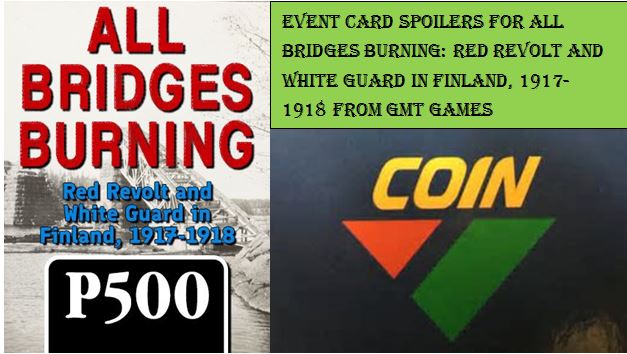For those that may not have seen the first few posts in this new feature, we have asked the designer of All Bridges Burning: Red Revolt and White Guard in Finland, 1917-1918 from GMT Games VPJ Arponen, to provide us with text of some of the proposed Event Cards and also to give a short summary of the historical background as well as their use in the game. We will plan to post these Spoilers every 7-10 days over the next few months, or even longer if Vez is up for it. We are very grateful for Vez and his willingness to do this for us and for our readers. Thank you for your hard work Vez!
In our 11th Event Card Spoiler post regarding All Bridges Burning, we take a look at card #35 Home Front. Please keep in mind that the artwork and layout of these cards is not yet finalized and is only for playtest purposes at this point. Also, as the game is still in development, card details may still change prior to publication.
35. Home Front
 The shaded part of the Event card refers to the train sent by the Reds to Russia to fetch grain for the purposes of relieving the food supply pressures faced by the Red administration in Finland. In early February 1918, one of the leaders of the Red revolt and a former leader of the Finnish parliament, Oskari Tokoi (see Event #20), had traveled to St. Petersburg to negotiate on grain trade matters with the Russian Bolshevik government there.
The shaded part of the Event card refers to the train sent by the Reds to Russia to fetch grain for the purposes of relieving the food supply pressures faced by the Red administration in Finland. In early February 1918, one of the leaders of the Red revolt and a former leader of the Finnish parliament, Oskari Tokoi (see Event #20), had traveled to St. Petersburg to negotiate on grain trade matters with the Russian Bolshevik government there.
Among others, the chaos in the Russian railways prevented the Russians themselves from bringing the grain to Finland, so it was agreed that a group of trains, that soon got the nickname “Tokoi’s grain train”, were sent from Finland to do the job. Altogether three trains left Finland during the Spring of 1918. The first train left Helsinki on 19 February and the destination was the far away Siberian city of Omsk, over 2,000 miles (3,500 kilometers), one-way from Helsinki.
The trip was a downright adventure involving the abandonment of some of the wagons along the way. One source calculated the train’s average speed having been mere 10 miles or 15 kilometers per hour (Tainio, Jukka 2012. Tienhaarasta Vasempaan. Työväen historian ja perinteen tutkimuksen seura, Helsinki).
Five weeks later, however, the “grain train” returned to Helsinki and was a bit of a propaganda coup for the Reds. The novelist and a critic of the Red Revolt, Juhani Aho, sourly recorded in his diary on 31 March, in Helsinki:
Tokoi is now the hero of the day. He has had his grain train ―30 wagons― arrive from Siberia at the Helsinki railway station. The rumors at least say that it is grain, and that the grain that’s arrived is from Siberia. Unless this all is made-up theater.
Food shortages had plagued Finland even before the Civil War, something that the working class propaganda had continually used against the government. In that context, Aho continues:
It [the grain train] was received with much celebration. […] ‘Työmies’ [a Reds newspaper] is not entirely wrong to brag that this is one of history’s key events. It has branded the bourgeoisie as provocateurs and defamers of the working class, with undeniable shame, and shown that what the bourgeoisie government could never have achieved, the working class and its government indeed have.
The unshaded side of the card refers to the draft conscription of all 21 to 39 year old males ordered by the Senate military leadership on 18 February 1918, a good two weeks into the Red Revolt. By April, an estimated 11,000 conscripts fought the war on the Senate side.
An interesting fact about the Finnish Civil War was that even though it was fought along class division lines between the working class and the bourgeoisie, in particular the bourgeoisie ranks also contained significant numbers of rural and urban workers. This reflected differences in the conditions of the Finnish working class from region to region. The Finnish historian Ohto Manninen wrote:
…there was a certain class division evident between Reds and Whites, though this did not follow any line between the propertied and propertyless sections of the community […] those who leased land, who have traditionally been claimed for the Red side, were in fact to be found on both sides […] revolutionary attitudes were principally determined by social insecurity and alienation.
You can catch up on the series to date by following these links:
#3 November Revolution in Russia
#9 Declaration of Finnish Independence
#27 The Reds Launch a Major Offensive
#45 Finland’s Fate Hangs in Balance
#25 Disarming Russian Garrisons

If you are interested in All Bridges Burning: Red Revolt and White Guard in Finland, 1917-1918, you can pre-order a copy at the following link: https://www.gmtgames.com/p-675-all-bridges-burning-red-revolt-and-white-guard-in-finland-1917-1918.aspx
Also, check out our interview with the designer VPJ Arponen to get better insight into the game.
-Grant
